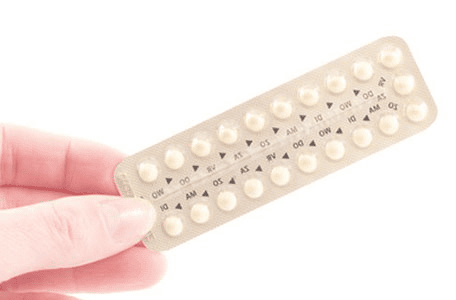This is an automatically translated article.
The drug Afirmelle contains levonorgestrel and ethinylestradiol and is available in kit form. Pills are used for maximum effectiveness in preventing pregnancy. However, Afirmelle can cause some unwanted side effects such as dizziness, headache, abdominal pain, stomach cramps... Therefore, patients need to learn detailed information about the drug at the same time. Consult your doctor before using the drug.
1. Mechanism of action of the drug Afirmelle
What does Afirmelle do? Afirmelle - a combined oral contraceptive by inhibiting gonadotropins. Although the main mechanism of the drug is suppression of ovulation, other changes include changes in cervical mucus that can increase the difficulty for sperm to enter the uterus and the endometrium can reduces nesting ability.
Absorption of Afirmelle
Although absolute bioavailability studies in humans have not been conclusively established, reports have shown that levonorgestrel is rapidly and completely absorbed after When taken orally, bioavailability is approximately 100% and is not subject to first-pass metabolism. Ethinyl estradiol is rapidly and almost completely absorbed from the gastrointestinal tract, but due to first-pass metabolism in the intestinal mucosa and liver, the bioavailability of ethinyl estradiol ranges from 38% to 48%.
Studies have also found that after a single dose of Afirmelle administered to 22 women under fasting conditions, the maximum serum concentration of levonorgestrel was 2.8 ± 0.9 ng/mL (mean ± SD) at 1 ,6 ± 0.9 hours.
At steady state, maximum concentrations of Afirmelle can be achieved from day 19 onwards, maximum levonorgestrel concentrations of 6.0 ± 2.7 ng/mL are reached at 1.5 ± 0, 5 hours after the daily dose.
The minimum steady-state serum concentration of levonorgestrel is 1.9 ± 1.0 ng/mL. The observed increases in levonorgestrel concentrations from day 1 (single dose) to day 6 and day 21 (multiple doses) were 34% and 96%, respectively.
Unbound levonorgestrel concentrations increased from day 1 to day 6 and day by 25% and 83%, respectively. The kinetics of total levonorgestrel are nonlinear due to increased binding of levonorgestrel to sex hormone binding globulin, which is thought to be due to increased levels of bioavailable hormone due to daily use of ethinyl estradiol.
After a single dose, a maximum serum concentration of ethinyl estradiol of 62 ± 21 pg/mL is reached after 1.5 ± 0.5 hours. At steady state achieved at least from day 6 onwards, maximum ethinyl estradiol concentrations were 77 ± 30 pg/mL and reached at 1.3 ± 0.7 hours after the daily dose. The minimum steady-state serum ethinyl estradiol concentration is 10.5 ± 5.1 pg/mL. Ethinyl estradiol concentrations did not increase from day 1 to day 6, but did increase by 19% from day 1 to day 21.
Distribution of the drug Afirmelle
Levonorgestrel in the serum is mainly bound to the bioavailable hormone. Ethinyl estradiol is approximately 97% bound to plasma albumin. Ethinyl estradiol does not bind to bioavailable hormones, but induces bioavailable hormone synthesis.
Metabolism of Afirmelle
Levonorgestrel: The most important metabolism occurs during Δ4-3-oxo reduction and hydroxylation at the 2α, 1β and 16β positions. Most of the metabolites circulating in the blood are sulfates of 3α, 5β-tetrahydro-levonorgestrel. While excretion occurs mainly as glucuronide. Some levonorgestrel also circulates as 17β-sulfate. Metabolic clearance rates may vary between subjects, and this may explain the wide variation in levonorgestrel concentrations between different users.
Ethinyl estradiol: The cytochrome P450 (CYP3A4) enzyme in the liver plays a role in the primary 2-hydroxylation oxidation reaction. The 2-hydroxy metabolite is further modified by methylation and glucuronidation prior to urinary and faecal excretion. Cytochrome P450 (CYP3A) levels vary widely among users and may explain the variation in the ratio of 2-hydroxylated ethinyl estradiol. Ethinyl estradiol is excreted in the urine and faeces as glucuronide and sulfate conjugates.
Excretion
The half-life of levonorgestrel is approximately 36 ± 13 hours at steady state. Levonorgestrel and its metabolites are excreted mainly in the urine, accounting for about 40% to 68%, and about 16% to 48% are eliminated in the faeces. The half-life of ethinyl estradiol is 18 ± 4.7 hours at steady state.
2. Indications and contraindications to the use of Afirmelle
Afirmelle is indicated for the prevention of pregnancy in women of childbearing potential using oral contraceptives as a method of contraception.
However, Afirmelle is contraindicated in women with certain conditions:
Thrombophlebitis or thromboembolic disorders History of deep vein thrombosis or thromboembolic disorders Cerebrovascular or coronary artery disease in individuals with a history of thromboembolic valvular disease Thrombotic arrhythmias Inherited or acquired thrombosis Diabetes is associated with the effects of vascular Headache with focal neurological symptoms Uncontrolled hypertension Current diagnosis or history of breast cancer, possibly hormone sensitive Endometrial carcinoma or neoplasm Other known or suspected estrogen dependence Abnormal genital bleeding of unspecified cause Liver adenoma or carcinoma, or active liver disease Known or suspected pregnancy Hypersensitivity to any ingredient of Afirmelle
3. Unwanted side effects when using Afirmelle
Using Afirmelle can cause some side effects for users. However, for each case, the level of side effects can be different.
Common side effects of Afirmelle include symptoms such as feeling dizzy or headache, or possible weight gain or loss, stomach cramps, menstrual cycle may be changed with spotting or bleeding mid-cycle blood. The drug can also cause dark patches of skin on the patient's face. Therefore, when using the drug, it is necessary to pay attention to avoid sunlight and use sunscreen or wear long clothes to protect the skin when going out in the sun. The rare side effects of Afirmelle can be serious and even fatal. These signs include: allergic reaction, itching, swelling, blistering, wheezing, unusual hoarseness. Or signs related to the liver such as dark urine, feeling tired, gray stools... Or signs related to the gallbladder with signs of pain in the upper right abdomen, yellow skin, fever with chills... When the patient experiences the above-mentioned signs, they should be taken to a medical facility promptly for treatment. Drug Interactions Afirmelle
Afirmelle may affect the results of some tests. Therefore, the patient needs to inform the doctor who tests this information to avoid possible errors when examining the patient. Or some medicines or herbs can make Afirmelle not work as well. Afirmelle may stimulate high cholesterol and triglyceride levels.
Some notes when using Afirmelle: Afirmelle is not able to prevent the spread of sexually transmitted diseases, so patients must still take protective measures when performing this activity.
Please dial HOTLINE for more information or register for an appointment HERE. Download MyVinmec app to make appointments faster and to manage your bookings easily.













